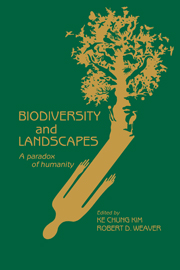Book contents
- Frontmatter
- Contents
- Contributors
- Preface
- Part I Introduction
- Part II Human values and biodiversity
- Part III Human processes and biodiversity
- 5 Preindustrial man and environmental degradation
- 6 Conserving biological diversity in the face of climate change
- 7 We do not want to become extinct: the question of human survival
- 8 Germplasm conservation and agriculture
- Part IV Management of biodiversity and landscapes
- Part V Socioeconomics of biodiversity
- Part VI Strategies for biodiversity conservation
- Part VII Biodiversity and landscapes: postscript
- Index
8 - Germplasm conservation and agriculture
Published online by Cambridge University Press: 04 August 2010
- Frontmatter
- Contents
- Contributors
- Preface
- Part I Introduction
- Part II Human values and biodiversity
- Part III Human processes and biodiversity
- 5 Preindustrial man and environmental degradation
- 6 Conserving biological diversity in the face of climate change
- 7 We do not want to become extinct: the question of human survival
- 8 Germplasm conservation and agriculture
- Part IV Management of biodiversity and landscapes
- Part V Socioeconomics of biodiversity
- Part VI Strategies for biodiversity conservation
- Part VII Biodiversity and landscapes: postscript
- Index
Summary
Introduction
Agriculture is a prehistory technology that still has a far-reaching impact on the planet. The quest for an assured food supply has done more to decrease biodiversity and physically alter the environment than any other activity in which we engage. Approximately 60% of the human population directly or indirectly makes their living from agriculture. Tragically, food production is population driven. As we produce more food, the human population becomes larger and the demand for increased yield creates an open spiral of greater impact on the land. Before the advent of agriculture, we lived like any other animal in the sense that we hunted and gathered our food daily, and on the days we were not successful we went hungry. Our population density did not exceed 1 person per 25 km2, and we were sustained on our forage territory. Today our density exceeds 25 persons per km2, and in the urban zones, such as the one between Boston and Washington, D.C., our density approximates 600 persons per km2 (Wilkes, 1989). Quite literally we are absolutely dependent on domesticated plants and animals and there is no turning back to hunting and gathering. Cultivated plants and domestic animals provide an assured food supply that liberates us from the daily quest for food so we can be free to engage in such human activities as the arts and learning and/or live at high densities in large metropolitan centers, but at what cost!
- Type
- Chapter
- Information
- Biodiversity and LandscapesA Paradox of Humanity, pp. 151 - 170Publisher: Cambridge University PressPrint publication year: 1994

